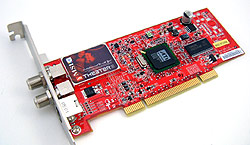
|
The 12-bit encoding engine boasts 2D
5-line comb filtering and a 3D comb filter. The 3D comb filter reduces
artifacting and colour bleeding in the final image.
82% Rating: 
|
|
|
|
Home >
Reviews >
Video Cards >
MSI Theatre 550 Pro |
|
|
In Use: The Remote
We were not fond of the
buttons on MSI's white remote control, as they were rather soft and
imprecise. They did function well on the whole though, and this remote
includes some great features.

The most notable addition to
previous 'media centre' remotes we have seen is MSI's use of a multi-directional
pad and toggle button to emulate mouse movements. This is not the most precise
way of controlling your system, since navigation tends to be clumsy over the
infra-red link, but it's much better than having to reach for the mouse each
time you want to change something that isn't on the main menu of your media
software.
Range was good with this
device, as was the angle at which we could use the remote.
Picture quality, video/audio
Synchronization
 The video capture quality of the MSI
Theatre Pro 550 is great. When capturing digital video from a Satellite TV
connection on 'best' quality, we were unable to tell the difference between the
original and recorded signals. Looks like the Theatre 550 Pro chip's comb filtering features pay off. The video capture quality of the MSI
Theatre Pro 550 is great. When capturing digital video from a Satellite TV
connection on 'best' quality, we were unable to tell the difference between the
original and recorded signals. Looks like the Theatre 550 Pro chip's comb filtering features pay off.
Better yet, we saw no sign of dropped
frames, even at best quality. Video quality dropped as we lowered the capture quality, but the results
were still very good. Audio and video appeared to be perfectly in sync on all
our tests.
The 'live TV' PowerCinema applet
turns on video streaming automatically, degrading picture quality
noticeably. This is not surprising since all video data is being
compressed onto the hard drive, then streamed to the display after a slight
delay, enabling the pause, rewind and fast-forward PVR functionality of the
Theatre 550 Pro.
There is no apparent way of turning the streaming off, so
watching TV through the MSI Theatre 550 Pro is always going to be slightly
inferior to the original signal. The same can be said for most PVR
devices though.

Picture quality was still good,
and excellent on static images. Slight blurring and artifacting
was visible on fast moving sections of the display. Frame rates
remained perfect as did audio/video synchronization, even when
fast-forwarding and rewinding.
Conclusions
Like the
other ATI Theatre 550 Pro-based card we looked at, the hardware functionality of
the MSI Theatre 550 Pro is great. It's hard to imagine what more could be asked
from a basic TV tuner.  While it is missing high-end features like HDTV-compatibility and
the ability or extras needed to tune in a purely digital signal, this card
excels at everything else it does.
While it is missing high-end features like HDTV-compatibility and
the ability or extras needed to tune in a purely digital signal, this card
excels at everything else it does.
The bundled software is functional, but rough around the
edges. CyberLink's PowerCinema 3 does everything you'd want it to, but
puzzling errors like the inability to change the directory used to store
recorded video reduce its ease of use for anyone except absolute
novices.
ATI's
Theatre 550 Pro functions with Microsoft's latest Windows XP Media Centre
operating system, and this may well provide a better home for the MSI Theatre 550 Pro's abilities than CyberLink's offering.
Since the other Theatre 550 Pro card we have tested came with an identical
software bundle and almost identical hardware, we have a feeling that this is
the default package that ATI is providing to its license partners, which is a
pity given the excellence of the hardware and the flaws in the
software.
Ignoring
the software though, at a price of US$75 (CAD$90) it's hard not to recommend the MSI
Theatre Pro 550 against other mainstream TV-tuners out there, so we will.
Find out
about this and many other reviews by joining the Weekly PCstats.com Newsletter today!
Catch all of PCstats latest hardware reviews right here.
Related Articles
Here are a
few other articles that you might enjoy as well...
1. Albatron Trinity GeForce 6600GT AGP Videocard Review
2. MSI NX6600GT-VTD128 Geforce 6600GT AGP Videocard Review
3. PowerColor X700 PRO Videocard Review
4. Gigabyte GV-NX66T128D GeForce 6600GT Videocard Review
5. Gigabyte GV-RX70P256V X700 PRO Videocard Review
|
